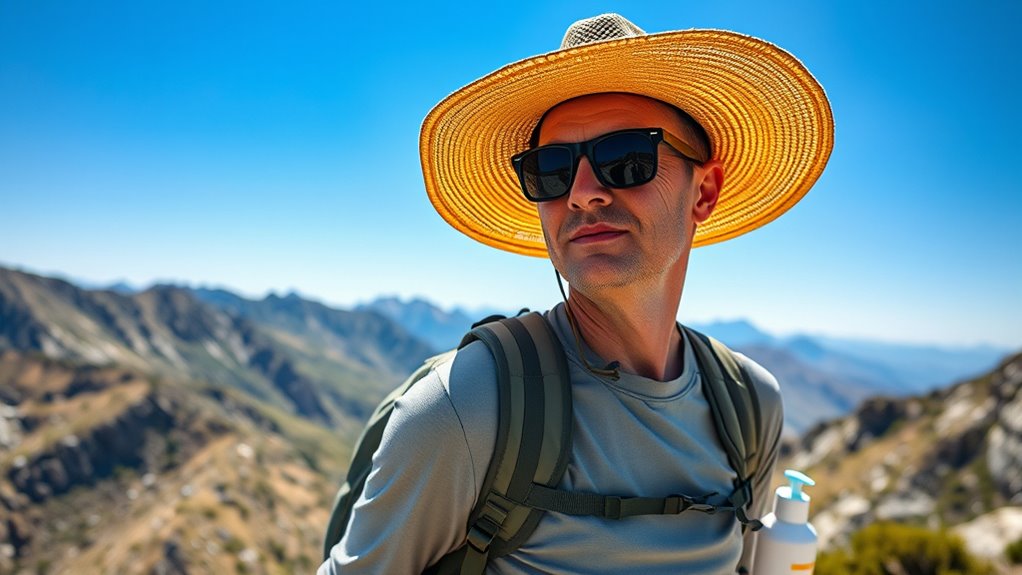To protect your skin on epic walks and pilgrimages, apply broad-spectrum sunscreen with SPF 30+ generously before starting and reapply every two hours. Cover exposed skin with protective clothing like hats and long sleeves, and carry hydrating skincare products to keep skin moisturized. Use gentle wipes during breaks to cleanse sweat and dirt, then reapply moisturizer. Staying mindful of environmental stresses and adjusting your precautions can help maintain your skin’s health throughout your journey. Continue to discover how you can stay protected effectively.
Key Takeaways
- Apply broad-spectrum SPF 30+ sunscreen generously and reapply every two hours during your walk or pilgrimage.
- Wear protective clothing like hats, long sleeves, and sunglasses to shield skin from UV rays and environmental elements.
- Regularly cleanse your face with gentle wipes or cloths at rest stops to remove dirt and sweat, then reapply moisturizer.
- Keep skin hydrated with moisturizers containing hyaluronic acid or aloe vera, and drink plenty of water to support internal hydration.
- Be mindful of environmental stressors such as wind, dust, and temperature changes, and adjust your protective measures accordingly.

Starting on epic walks and pilgrimages can be transformative experiences, but they also expose your skin to various environmental stresses. Sun exposure, wind, dust, and changing temperatures can take a toll on your skin’s health and appearance. That’s why proper protection is vital to guarantee you enjoy your journey without unnecessary discomfort or damage. A key aspect of this protection is consistent sunscreen application. You should apply a broad-spectrum sunscreen with at least SPF 30 generously to all exposed skin before setting out. Don’t forget often-overlooked areas like your ears, the back of your neck, and your hands. Reapply every two hours, especially if you’re sweating or wiping your face frequently, to maintain effective coverage. Sunscreen acts as a barrier against harmful UV rays that can cause sunburn, accelerate skin aging, and increase the risk of skin cancer. Alongside sunscreen, maintaining skin hydration is equally important. Long hours outdoors, combined with wind and sun, can dehydrate your skin quickly, leading to flakiness, irritation, and discomfort. Carry a good moisturizer and apply it regularly, especially after washing your face or sweating. Hydrated skin stays more resilient, helping you avoid chapping and keeping your skin supple. Drinking plenty of water throughout your journey supports internal hydration, which directly benefits your skin’s health. It’s also wise to include hydrating skincare products with ingredients like hyaluronic acid or aloe vera, which can boost your skin’s moisture levels. These products work well under sunscreen and moisturizer, creating a protective layer that shields your skin from environmental stressors. As you walk, be mindful of how your skin reacts to different conditions. Wind and dust can strip away natural oils, so cleansing your face with gentle wipes or a soft cloth during rest stops helps remove dirt and sweat that can clog pores. After cleansing, reapplying moisturizer will restore your skin’s barrier. Remember, protecting your skin isn’t just about the products you use; it’s about establishing a routine that prioritizes consistent coverage and hydration. Wearing protective clothing, such as hats and long sleeves, can further shield your skin from direct sunlight and environmental pollutants. Staying mindful of your skin’s needs and responding with timely sunscreen application and skin hydration guarantees you won’t just endure your journey but thrive through it. Being aware of how outdoor conditions affect your skin can help you adapt your protective measures accordingly. By taking these simple steps, you’ll preserve your skin’s health, reduce discomfort, and enjoy your epic walk or pilgrimage to the fullest.
Frequently Asked Questions
How Can I Prevent Chafing During Long Walks?
To prevent chafing during long walks, choose clothing choices that fit well and are moisture-wicking to keep your skin dry. Apply chafing remedies like anti-chafing balms or powders before your hike, especially in hot or humid conditions. Stay proactive by taking regular breaks to adjust clothing and reapply remedies if needed. Staying mindful of friction points helps you stay comfortable and enjoy your journey without discomfort.
What Are the Best Natural Remedies for Skin Irritation?
For skin irritation, you can try natural remedies like applying Aloe vera gel, which soothes and heals your skin. Herbal compresses, made from calming herbs like chamomile or calendula, reduce inflammation and provide relief. Keep your skin moisturized and avoid irritants. These natural options are gentle, effective, and help your skin recover faster during long walks or pilgrimages.
How to Protect Lips From Sun and Wind Damage?
Protecting your lips is like shielding a delicate flower from harsh weather. To keep them safe, apply a nourishing lip balm regularly, especially before exposure. Use sun protection tips like choosing a balm with SPF and reapplying often. Wind can strip moisture, so keep lips moisturized and covered when venturing outdoors. Consistent care guarantees your lips stay soft, protected, and resilient against sun and wind damage.
What Should I Do for Blister Prevention and Treatment?
To prevent blisters, you should wear well-fitting, moisture-wicking shoes, and use blister prevention techniques like applying moleskin or padding on hot spots. Keep your feet dry and change socks regularly. If a blister forms, clean the area with antiseptic, avoid popping it, and cover it with a sterile bandage. For treatment options, rest and elevate your foot, apply cold packs to reduce swelling, and consider over-the-counter pain relievers.
How Can I Maintain Skin Hydration in Dry Environments?
Ever wonder how to keep your skin from drying out in harsh environments? You can do it by mastering moisturizing techniques—apply a thick, barrier-repair moisturizer regularly and consider using a humidifier if possible. Don’t forget to eat hydrating foods like cucumbers and oranges to boost internal hydration. Stay consistent, and your skin will stay supple and protected, even when the air around you feels parched.
Conclusion
As you set out on epic walks and pilgrimages, remember that your skin’s protection is just as vital as your journey’s purpose. While the road may stretch endlessly, neglecting your skin can turn a sacred adventure into a painful ordeal. Protecting your skin isn’t just about avoiding burns or scars; it’s about honoring yourself on this soulful path. In caring for your skin, you preserve the spirit of your pilgrimage, making every step meaningful.









